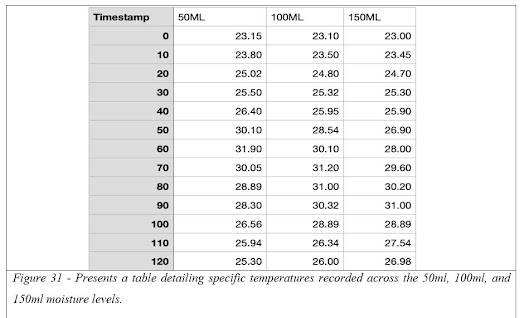KOMPOT - MVP Experimentation
Test 1
A test was conducted with 400 grammes of Verve B&Q compost topsoil by the manufacturer of the KOMPOT prototype to check the temperature and humidity viability of the KOMPOT bin. The test was run for five consecutive days, with ambient temperature checked each morning at 9:00 am. Throughout the experiment, the outside temperature was recorded as follows: “Day 1 = 13.4°C, Day 2 = 14.7°C, Day 3 = 12.3°C, Day 4 = 11.4°C, and Day 5 = 10.8°C”. The minimum and maximum temperature thresholds were identified, with 25°C as the lowest and 30°C as the highest. This threshold was determined to test whether the KOMPOT bin runs with predefined temperature limits. The temperature log that was obtained from the smart processing of the DHT22 sensor was plotted in the graph form to summarise the temperature logs for the whole experimentation duration for 120 hours (Webster, 2024a).
Test 2
Test 2 allows for an examination of how changes in
moisture levels affect thermal conductivity, heat retention, and overall
temperature stability. Such insights are key to refining the control system's
algorithms and optimising heat distribution mechanisms to ensure precise and
consistent temperature regulation throughout the composting cycle.
Test 2 Displays the temperature variations observed over 2 hours for each of the three different moisture levels: 50 ML, 100 ML, and 150 ML.
When moisture is introduced into the composting material, it facilitates better heat retention by increasing the thermal conductivity of the material. This enhanced thermal conductivity allows for more efficient distribution and retention of heat throughout the composting mass, resulting in a slower temperature increase. As moisture levels fluctuate, they influence various factors such as microbial activity, decomposition rates, and heat generation, all of which contribute to the overall temperature profile within the composting unit.



Comments
Post a Comment